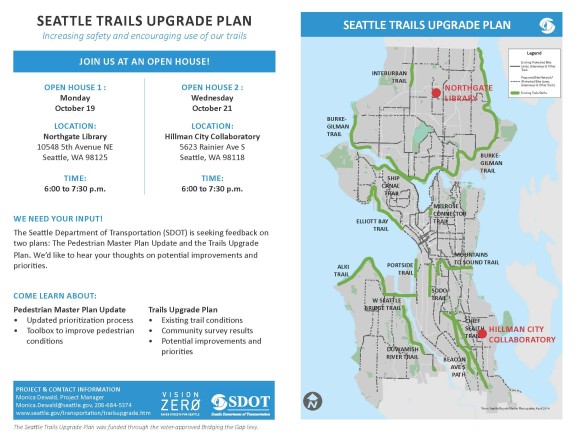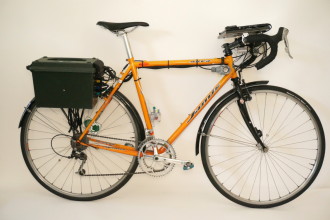

In recent weeks, workers have been biking a crazy bike outfitted with instruments to measure trail conditions all over the city.
The results are just one tool the city will use to craft its Trails Upgrade Plan, which will guide investments in repaving and redesigning Seattle’s great, though sometimes incomplete or deteriorating trail system. For more on that plan, see our previous story.
The plan also depends on people like you giving input on the most needed work, and you have two chances next week to tell staff in person:
- Monday, 6 – 7:30 p.m. at Northgate Branch Library
- Wednesday, 6 – 7:30 p.m. at Hillman City Collaboratory
Staff at the open houses will have some results from their data collecting efforts.
Walking and biking are the way many of us get around, and are zero-emission solutions that are also healthy travel options. The city is working to create a high-quality pedestrian and bicycle network that connects to places people want to go.
Please join SDOT at our Seattle Trails Upgrade Plan Open House on Monday, October 19/Wednesday October 21 to share your input on potential trail improvements and priorities.
This past summer, SDOT and Alta Planning + Design teams used a modified road bike affectionately called FrankenBike to map 40 miles of Seattle’s paved trails. With technology such as helmet-mounted video cameras and a customized tablet computer, teams recorded field observations on the spot. The data will contribute to the Trails Upgrade Plan that will make trails safer and more appealing to people who frequent them.
Data isn’t enough to plan improvements, we also value your opinions! Last month, we asked folks for feedback and suggestions to improve their trail experience. Using the technical data we collected and the communities input, we have developed recommendations to share at two open houses on Monday, October 19/Wednesday October 21 . We hope you join the conversation on how we can maintain and build safer, more comfortable trails.
For more information on the Seattle Trails Upgrade Plan, visit us here.








Comments
14 responses to “Two chances to guide Seattle’s Trails Upgrade Plan + Check out this crazy trail condition monitoring bike”
If I don’t make the meeting at Northgate I’d appreciate somebody asking if they’ve considered additional data gathering in the fall/winter. Seems like they should be able to find interns or volunteers to ride the trail network in the dark, after rains to report standing water on bike routes (Ravenna Blvd. anyone?), accumulations of fallen leaves that need collection, and places where blackberry vines (or other vegetation) grow in to the road/trail potentially striking riders or obscuring sight-lines. Planning for maintenance and creating a network that is rid-able in less than ideal conditions is important but perhaps less exciting than playing with their new toy on a sunny day.
Even if they can’t do the data collection themselves, how about a more effective referral system from Find It/Fix It?
The technological infrastructure is there to allow ordinary users to submit detailed local problem reports. My experience on the street is that SDOT usually fixes safety-related reports within a day or two — sometimes within hours.
On trails maintained by Parks? “We’ll have someone look at it and hope to maybe have it fixed by the end of the year.”
They also take input by email if you can’t attend. The project web site gives Monica.Dewald @ seattle.gov as contact.
What exactly is trails “upgrade?” Is it mainly about improving the existing trails, or will construction of missing links also count here? Maybe it is just me but I feel that by far the most important issue is connectivity…
I believe they’re in the process of creating a plan. They held an online survey recently (maybe a month or two ago?), and these meetings look like more input into that process. Though the materials I’ve seen indicate that this particular work is focused on off-street trails (owned by a variety of entities), and a lot of connective routes will have to occur in street ROWs (which generally have different challenges), I think comments emphasizing the importance of connectivity (general and specific) would be appropriate.
It would be so awesome if SDOT made an app for trail conditions. I use My Tracks which has GPS maps and stats of our daily school commute. Use the IMU in the phone to sense shocks, bumps and jolts, and you could utilize bike riders all over the city to input road data. If enough bumps kept showing at the same location it would show areas that need attention. The beauty would be that problem areas would turn up where SDOT didn’t even think to look. Maybe it could be an adjunct to the FindIt/FixIt app.
I have had the same thought. Phone sensors can do a lot. Article here — http://www.ripublication.com/irph/ijeee_spl/ijeeev7n6_09.pdf — for cars though.
” Nericell [4] uses mobile Smartphone to
monitor road and traffic conditions. It detects potholes, braking, bumps and honks using accelerometer, microphone, GSM radio and GPS sensors present in smart phones. It uses triggered sensing where the operation a high energy consuming sensor (GPS, microphone) is activated by a low energy consuming sensor (accelerometer, cellular radio) making the system energy-efficient. It uses strongest signal (SS)-based localization algorithm, so that the relevant location can be tagged with sensed information such as honking or bump”
This is a brilliant idea for a civic-minded app! How do we make this happen?
I will try to make it up there to advocate for a system-wide focus on nighttime visibility. This is actually the perfect meeting to bring it up at, since the problem is mostly specific to off-street trails. I’ll spare y’all a rehash of places with bad lighting conditions, but if I make the meeting I’ll bring a written list.
SDOT’s bike reminds me of a weather rock. Is it really necessary, and is it a good substitute for common sense? I generally prefer to invest in my community’s infrastructure but this next levy is a big one and SDOT is going to have to do better. Most of the projects I see for bicycles right now are poorly designed. Those bollards that get repeatedly run over and then turn into booby traps for one. The redo of Delridge is a fail. Yes, its wider, but it is still a glorified sidewalk on the wrong side of the street (for southbound riders) with cars perpetually blocking it. The narrow part next to the blind curve of the on ramp is still the worst part and wasn’t changed. I could go on and on. Maybe the people in charge of these projects should ride their bikes to work once in a while, during peak traffic hour. Not in the middle of the day with a police escort!
The bike is an off-road version of what’s becoming standard technology for road maintenance — automated pavement condition analysis.
The problem with common sense is that it takes a lot of human time, time to stop and write things down, time to determine exact positions, time for someone in home office to combine somewhat-subjective reports from multiple people with different priorities and experiences.
Automated pavement rating gives you consistent data across your entire network, with all the data GPS-tagged so you can match up the pavement roughness to the photos and overlay them on your GIS system to identify what’s wrong and who owns it.
Done right, it also lets you inventory what’s on the ground and update the GIS system with the exact location of every sign, every bollard, every reflective hazard marker, etc. That makes it possible to schedule periodic inspection and maintenance rather than waiting for people to report something gone wrong.
Like bike counters on trails, this is just bringing to bicycles the technology that’s already common for streets.
Since last Febrary, I have pleaded with SDOT (sending photos and emails) to cut the laurel hedge drastically back and align the curb cuts at NW corner of Montlake Blvd and E Shelby St. Blind corner for bikers and walkers. Curb cuts now put bikers into waiting cars or center triangle with curbs. Please act!
Hi, does anyone know where I can find a summary of the meeting, or at least some details what was discussed? I’m a regular commuter on the Chief Sealth trail and it would be interesting to see what kind of input they have regarding this section.
[…] investment comes after the city conducted a survey of trail conditions to prepare a trails upgrade plan. The city’s Parks District is also […]